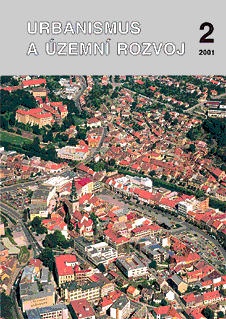
National Geographic Information System of Spatio−Technical Data of the Czech Republic, by Karel Maier
In 1999 the Ministry of Regional Development’s Physical Planning Section assigned the elaboration of a geographic information system of Czech spatio-technical data to the Faculty of Architecture of the Czech Technical University. The aim of the job was
– to collect and evaluate the existing data bases of thematic and departmental geographic information systems, easy to be employed as spatio-technical data
– to transform the collected data into a comprehensive information system, enhancing it
– by a synthetic map of spatio-technical data of the Czech Republic
– to verify the applicability of the geographic information system on examples, in the form of value maps of the Czech Republic
– to create a system of metadata, i. e. data giving information on the data of the geographic information system
The job was carried out in a few distinct phases, during 1999 and 2000. Since the knowledge of the quality and contents of the data was very limited in the beginning, a rather iterative procedure was applied, so that both the contents and the methods could be rectified wherever necessary. Such an opportunistic approach was probably appropriate, as the final shape of the Geographic Information System of Spatio-Technical Data seems to be a coherent work, providing abundant information on relevant spatial facts on a nation-wide scale.
The Jewish Quarter of Třebíč Stands for Registration in a Prominent List. An interview with the Town Architect
UPSD has brought several articles on the concerns of the town of Třebíč, in West Moravia. Recurring to Třebíč once again in this issue, the Town Architect, Mr Lubor Herzán, is presented in an interview. Member of a family of architects, master builders, and university teachers, and Head of the Section of Architecture and Physical Planning in his hometown, Mr Herzán has a large share in the regeneration of the Jewish Quarter, these days expecting a distinguished acknowledgement.
Evaluating the Urban Usability of Space, by Stanislav Kovář
Computers can quickly process large amounts of data on space, in the procedure of “exact urban planning”. Nevertheless, while a lot of time and energy is consumed on discussing the standardization of data files or graphic outputs, it seems necessary now to contemplate the best possible usage of such computerized information. It is impossible to create a good model of data processing without an idea of the practical usage of such data. Physical planning is certainly one of those disciplines in which relevant data can be used passively, for the purpose of statistics, but also actively, in a creative manner.
Visions and Prospects of Moravian Towns, by Antonín Vaishar
The Brno branch of the Academy of Sciences‘ Institute of Geonics is working on a research project called Geography of Moravian Towns. The position of small towns in the habitation system of Moravia is to a large extent specific. After 1990, considerable changes and new barriers occurred in the preconditions of the prosperity of small towns. The article deals with some possible roles small towns in Moravia can play in administration, industry, travelling, and various special activities. The positions of towns are more and more varied, only a small part of them being ready to become real centres of micro-regions. The rest can either see their prospects in specializations or will become integral part of rural areas.
Flood Damage, by Ladislav Pavlovský & Pavel Bíza
Three and a half years have passed now since July 1997 when huge floods hit large areas of the Czech Republic, mainly the Morava river basin above its Dyje confluence, and the Odra basin. Despite the efforts of water industry specialists, hardly anyone can even today rely on fully avoiding the dangers of material and immaterial damage through floods. The article outlines a few basic factors of the flood danger, besides the powers of nature. First, there are some heavily urbanized areas along rivers. Detailed maps show that virtually all towns or villages of the Czech Republic are on rivers, which would at floods become outspread streams, or brooks, which would convert into raging rivers. Another important circumstance is the costs of efficient flood protection. However, high population density does require expensive measures to protect people and their settlements. Third item is the tendency to underestimate the benefits of water industry, the success of its comprehensive tasks being measured in time dimensions of more than one or two generations. An integrated synthesis of every flood characteristics is therefore highly important. Fourth, there were some human intrusions on the landscape altering the flow regime, mainly the ground adaptations in 1949-1990 and some other actions shortening and straightening up the streams and urbanizing alluvial plains. A solution to these questions is hard to find. On one hand, we face the requirement of sustaining a good quality of human life under varied economic, social, and natural conditions; on the other hand, environmental strategies in water industry and physical planning are of foremost importance. Recent floods, as we can remember, destroyed houses, spoiled water resources, pipes, and clearing technologies, damaged grounds and communications, and brought immense losses in agriculture, industry, and services, and even of human lives.